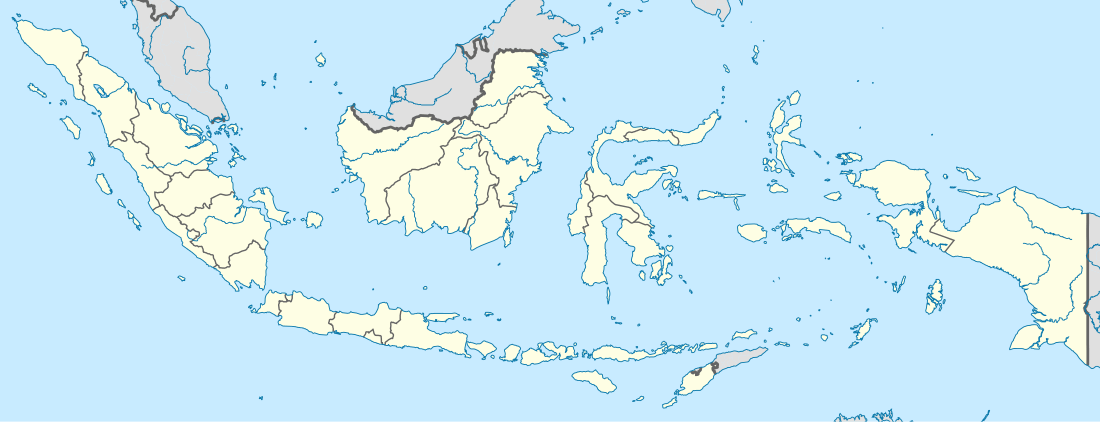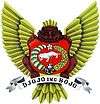Kediri, East Java
| Kota Kediri | |||||
|---|---|---|---|---|---|
| City | |||||
Clockwise, from top left : View of Mount Wilis and the Brantas River at Kediri, Surowono Temple, Alun-alun Kediri | |||||
| |||||
|
Motto: Joyo ing Boyo (Indonesian: Glory in the catastrophe) | |||||
 Kota Kediri | |||||
| Coordinates: 7°48′59.8″S 112°0′42.9″E / 7.816611°S 112.011917°ECoordinates: 7°48′59.8″S 112°0′42.9″E / 7.816611°S 112.011917°E | |||||
| Country | Indonesia | ||||
| Province | East Java | ||||
| Government | |||||
| • Mayor | Abdullah Abu Bakar, S.E | ||||
| Area | |||||
| • Total | 63.4 km2 (24.5 sq mi) | ||||
| Elevation | 3 m (10 ft) | ||||
| Population (2003) | |||||
| • Total | 252,000 | ||||
| • Density | 3,975/km2 (10,300/sq mi) | ||||
| Time zone | WIB (UTC+7) | ||||
| Website | www.kotakediri.go.id | ||||
Kediri is an Indonesian city, located near the Brantas River in the province of East Java on the island of Java.
Archaeological artefacts discovered in 2007 appeared to indicate that the region around Kediri may have been the location of the Kediri kingdom, a Hindu kingdom in the 11th century.[1]
The city is a major trade centre for the Indonesian sugar and cigarette industry.[2]
History
The Brantas River valley was known as the site of classical Javanese culture, particularly between the 10th and 15th centuries. The town of Kediri was established by King Airlangga on the banks of the upper Brantas river in 1042. It was originally called Dahanapura or Daha. After the death of Airlangga his kingdom was divided into two parts: the kingdom of Panjalu in the west, and the kingdom of Janggala in the east. Daha became the capital of Panjalu, and later the capital of the Kediri kingdom.[3]:146–147,158 Over the centuries, control of the city passed to the Singhasari, Majapahit, Demak and Mataram kingdoms.
The name "Kediri", or "Kadiri", is derived from the Sanskrit word Khadri, meaning Indian Mulberry, indicative of the mulberry trees (locally known as pacé or mengkudu) which grew in the area.
After the era of the Javanese kingdoms, Kediri went into decline, becoming a small rural settlement, which was later annexed by the Dutch East India Company (VOC) as part of the Dutch conquest of Java. East Java in the 1740s was controlled by Cakraningrat IV, a Madurese regent who was favorably disposed toward the VOC, as he believed the Dutch would help him in securing the independence of Madura from the Kasunanan Kartasura kingdom. However, when his plans were rejected by the VOC, Cakraningrat rose against the Europeans. The rebellion was ultimately suppressed by the VOC, assisted by two generals sent by Pakubuwana II, Sunan Kartasura. Kediri then became part of the VOC and remained under Dutch control until the independence of Indonesia in 1945.[4]
Kediri began to flourish when the Dutch East Indies founded the autonomous Gemeente Kediri in 1906. Zelfstanding Gemeenteschap (self-government with full autonomy) was granted in 1928.
During the Indonesian National Revolution in 1945–1949, Kediri became a target of General Sudirman's guerrilla campaign. In 1965, after the failed 30 September Movement coup, Kediri suffered terrible bloodshed in which thousands of people were killed.
The Gudang Garam kretek tobacco industry was established in 1958 by Chinese Indonesian Tjoa Ing Hwie. He purchased vast lands in Kediri and established a kretek cigar factory. Today, Gudang Garam is the major employer of the city, with more than 40,000 workers.
Society and Culture
Being the site of an ancient capital of Javanese kingdoms, the city is one of the major cultural center for Javanese people, the city also contains some ancient ruins and candis that dates back to the era of Kediri and Majapahit kingdom.
Sport
Kediri is home of Persik Kediri which plays in Premier Division of Indonesian Football League. Persik Kediri has won total two title of Premier Division of Indonesian Football League, last occurring in 2006.
Education
Kediri city has Three National Universities, they are Universitas Brawijaya, STAIN Kediri, Politeknik Negeri Kediri. Kediri also has many private institutions for higher-education, such as Institut Ilmu Kesehatan Bhakti Wiyata, Universitas Nusantara PGRI Kediri, Universitas Kadiri, and Universitas Islam Kadiri.
Tourism
The part of Kediri city have a good place like Gua Maria Pohsarang, Kediri Waterpark
References
- ↑ Kediri archeological discovery offers clues on ancient kingdom, The Jakarta Post, 24 March 2007.
- ↑ Kediri, Encyclopædia Britannica.
- ↑ Cœdès, George (1968). The Indianized states of Southeast Asia. University of Hawaii Press. ISBN 9780824803681.
- ↑ History of Kediri by City Council


